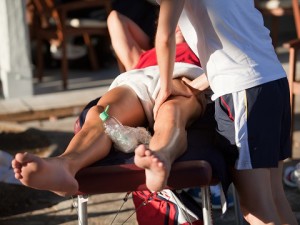Bodywork, Foam Rollers, & Percussion for Athletes with Myology
Coach Chris Newport talks with Vincent Bounds, owner of Myology Sports Massage to see how athletes can best use massage and bodywork to recover.
They have a unique business model for massage and bodywork. Instead of having a brick and mortar location, they go to other gyms and facilities throughout the Triangle and Greensboro to better meet athletes where they are.
Don’t expect any pan flutes or sheet magic. They do sports and movement based bodywork, where athletes come clothed in order to get optimal joint mobility.
How often should athletes get bodywork?
Vincent describes how often an athlete needs to get bodywork. Generally, he says that most athletes do well getting bodywork about every 4-6 weeks, but it may need more or less based on their goals and where they are in their training. Your bodywork should follow your periodized training program, increasing with more training volume and intensity.
Learn how stress can affect how your bodywork, why building tensegrity is important and why bodywork shouldn’t hurt in order to be effective.
How to use self-care tools effectively
Hear Vincent’s philosophy on teaching athletes how to properly use self-care tools so they use them more effectively.
For example, learn which percussion guns are better quality, like Theragun or Hyperice, and which ones are not worth your money.
Learn how foam rolling can be the most successful (hint: it’s not all about lounging around, but pinning and focusing on small areas).
While he would love to say that bodywork replaces athletes self care like stretching, yoga or foam rolling, Vincent says why bodywork is NOT a replacement.
Here’s why you should warm up before a workout
For pre-workout, focus on stimulating blood flow by articulating joints that will be used for the workout, know what to avoid and why some athletes can get away with less warm up then others. Like he mentions early on in the podcast, it’s all about experience and tensegrity.
BONUS:
Learn what muscle is an “upper body killer” and how this may affect your streamline position as well as your seated posture, especially when you’re working from home. It’s pretty simple and can be done seated or standing.
Here’s Vincent’s main tips for you to take home:
- Don’t be afraid to ask questions so you can be the most informed about what tools, techniques and movements are best for your performance and recovery.
- Warm up, cool down and be sure to get your bodywork!
Book a massage with Myology here: http://myologysportsmassage.com/
Want to work with us for coaching, nutrition or testing?
Book a free consult here.
Follow us:
Instagram: @TheEnduranceEdge
Facebook: @theenduranceedge
Instagram: @CoachChris_RD
Instagram: @MyologySportsMassage
Facebook: @MyologySportsMassageTherapy
Have a guest or topic you want covered on the Find Your Edge podcast? Let us know!
Contact us and let us know!




